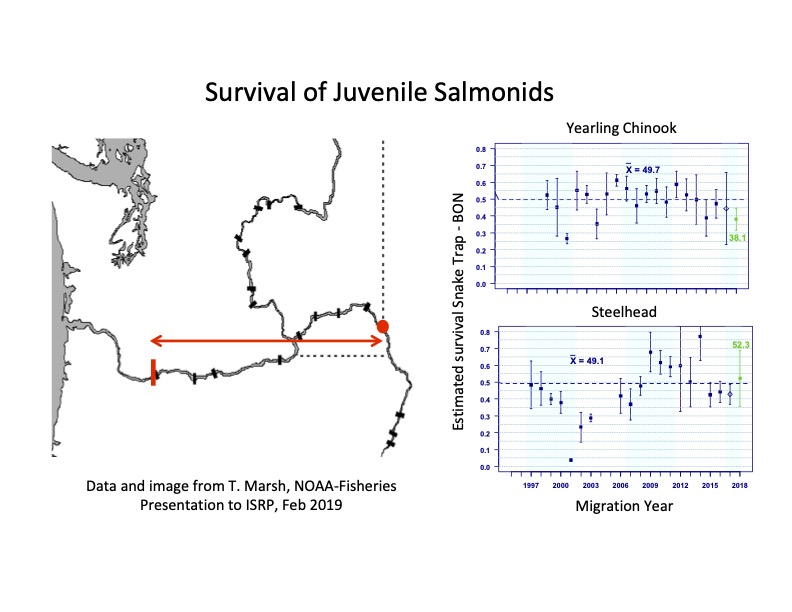forum
library
tutorial
contact

Breaching Dams to Save
Salmon Could Cost $27B
by Jennifer Yachnin
E&E News, June 9, 2022
|
the film forum library tutorial contact |

|
Breaching Dams to Save
by Jennifer Yachnin
|
The region would substitute the 1,000 megawatts of electrically produced by the dams annually,
as well as nearly 100 miles of navigable river used to transport agricultural products like wheat.
 Protecting the future of the Pacific Northwest's salmon could cost upward of $27 billion -- a huge price tag that would cover the breaching of four controversial dams, replacement of energy production, new irrigation infrastructure and transportation changes -- according to a new report.
Protecting the future of the Pacific Northwest's salmon could cost upward of $27 billion -- a huge price tag that would cover the breaching of four controversial dams, replacement of energy production, new irrigation infrastructure and transportation changes -- according to a new report.
Washington Gov. Jay Inslee (D) and Sen. Patty Murray (D) released the first draft of their proposal on how to address the future of the Lower Snake River, including the Ice Harbor, Lower Monumental, Little Goose and Lower Granite dams and locks.
The Democrats emphasized, however, that their draft report does not specifically endorse whether to remove or retain the four dams, although it does highlight the benefits of removing the earthen berms for the salmon, steelhead and lamprey that live in those waters.
Although more than $17 billion has been spent over 30 years on species mitigation efforts, the salmon remain on the verge of extinction due to warming waters and predators.
"We continue to approach the question of breaching with open minds and without a predetermined decision," Inslee and Murray said in a joint statement, adding that the report will accept public comment over the next 30 days.
"Every community in the Pacific Northwest knows the value and importance of our iconic salmon runs -- and every community recognizes the importance of salmon to our economy and cultural heritage," the statement continued. "We each remain firmly committed to saving our salmon. We also know that the dams provide significant benefits to our region's economy and communities. In the coming weeks, we will carefully review and consider public input, tribal consultation, and other engagement from stakeholders before making any recommendations."
Native Americans and environmentalists have long pressed the Army Corp of Engineers to remove the dams, completed between the 1960s and 1970s, to ensure the survival of salmon in the Columbia River basin.
But that decision would also force the region to find a substitute for the 1,000 megawatts of electrically produced by the dams annually, as well as nearly 100 miles of navigable river used to transport agricultural products like wheat.
Draining the existing reservoirs would also require new infrastructure to aid farmers who rely on those bodies of water and the elevated groundwater levels they create to water crops.
To address those issues, as well as to breach the dams, could cost at least $10.3 billion to as much as $27.2 billion, with additional "anticipated costs," the draft report states.
Those figures echo a plan introduced by Idaho Rep. Mike Simpson (R) in 2021, which suggested breaching the dams, replacing energy resources, addressing irrigation needs and managing fish recovery at a cost of $33.5 billion (E&E Daily, Feb. 8, 2021).
The 1,100-mile-long Snake River is also enmeshed in a long-running legal battle.
A federal judge last year issued a stay in one such case that seeks to block a Trump-era dam operations plan, as the Biden administration and plaintiffs in the case, including fishing and conservation groups and the Nez Perce Tribe, seek a resolution. The case is on hold until July (E&E News, Oct. 27, 2021).
Inslee and Murray's draft report notes that the process to remove the dams would be complex, requiring congressional authorization to the Army Corps, as well as a "comprehensive funding strategy."
Trout Unlimited President and CEO Chris Wood praised the possibility of restoring a free-flowing Snake River, noting it would be "the most significant salmon recovery action of our lifetimes."
"The report confirms that the dams' services can be provided in alternative ways. Now it is time to invest in those alternatives and restore a free-flowing lower Snake River before it is too late," Wood said.
Related Pages:
Washington Punts on Fate of Lower Snake River Dams by Jeremy P. Jacobs, E&E News, 12/23/19
learn more on topics covered in the film
see the video
read the script
learn the songs
discussion forum
